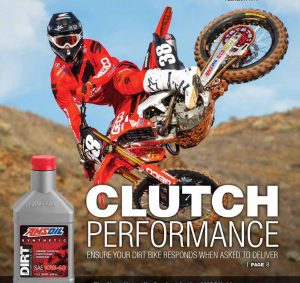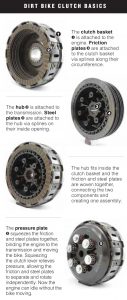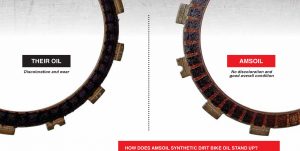
We had a great call from a local customer looking for the best oil to protect his motorcycle, A Kawasaki KLR650. Our new customer does a lot “adventure riding” and some off road riding and wanted the best protection and performance possible. The recommended product was a relatively new arrival to the product line which is the Synthetic Dirt Bike Oil line available in 10w40, 10w50 and 10w60. For many offroad riders clutch performance is critical to ensure an enjoyable ride. Regardless if you are a top level racer or a weekend warrior the key is that: Your Dirt Bike Responds When Asked to Deliver

Confident Clutch feel is the number one benefit we list on AMSOIL Synthetic Dirt Bike Oil labels. It’s also the primary value proposition featured in our dirt bike ads. But what does it mean?
Riding effectively demands confidence . It’s true whether you are a GEICO/AMSOIL/Honda professional Christian Craig or a weekend warrior hitting the trails near home. Confidence stems from experience with the bike and familiarity with the terrain. But it also derives from knowing your bike is going to respond the way you want for the entire ride. Riders want progressive, repeatable clutch-lever feel from the time they let the clutch out until they cross the finish line.
Take, for example, the start of a typical motocross race. Riders want firm positive clutch level feel as they rev the engine in anticipation of the gate dropping. When the gate drops, they want the bike to hook-up smoothly and with consistent power so they can grab the holeshot. Again, as they work up through the gears, clutch-lever feel should be crisp and consistent, not sloppy and loose. It’s no different on the trails around home. Each time riders maneuver around an obstacle on the trail or accelerate down a straightaway, they want consistent, crisp shifts.
OIL IS KEY
The transmission lubricant plays a vital role in clutch feel. To see why, you need to know how a dirt bike clutch works. The clutch connects the engine and transmission via a series of alternating friction and steel plates (see images at right). When the rider squeezes the clutch lever, the pressure plate separates the
steel and friction plates, allowing them to rotate independently. This allows the bike to idle without moving. As the rider lets out the clutch lever, the pressure plate squeezes together the friction and steel plates. This binds the engine to the transmission and moves the bike.
The transition from the friction and steel plates spinning independently to becoming bound together is an example of dynamic friction. Once the plates are locked together and spinning in unison, they’re subject to the principles of static friction.
Motor Oil plays a vital role in both areas- The formulation influences dynamic friction, which is best thought of as clutch feel. Oils with incorrect frictional properties can result in inconsistent or loose clutch feel. This negatively affects your ability to confidently start quickly and grab the holeshot in a race or maneuver around obstacles on the trail. The oil also contributes to the holding power, or static friction, between the plates once the clutch lever has been let all the way out. Oils with incorrect frictional
properties can allow the plates to slip in some circumstances, which you’ll feel as lost power to the ground. This is more common in motorcycles.
A powerful V-twin riding up a hill, for example, can generate sufficient load to cause the clutch plates to slip and the bike to surge. The oil’s additive chemistry has the greatest effect on performance. Friction modifiers added to some passenger car and light truck motor oils to maximize fuel economy can decrease the coefficient of friction within the clutch pack and result in excessive slippage. Extreme-pressure
additives, commonly used in gear lubes to protect against shock loads and intense pressures, can cause excessive clutch slippage and related damage.
The key is to use a lubricant specially formulated for wet clutches. AMSOIL Synthetic Dirt Bike Oil (DB40, DB50, DB60) and Synthetic Dirt Bike Transmission Fluid (DBTF) contain no friction modifiers or extreme additives. They’re dialed-in with the correct frictional properties to promote smooth
shifts and consistent clutch feel while guarding against wear for long clutch life.
What’s the difference between AMSOIL Synthetic Dirt Bike Oil and AMSOIL Synthetic Dirt Bike Transmission Fluid?
AMSOIL Synthetic Dirt Bike Oil is the primary recommendation for lubricating the clutch in some dirt
bikes. But Synthetic Dirt Bike Transmission Fluid is the primary recommendation in other bikes. What gives? While Synthetic Dirt Bike Oil delivers excellent clutch protection and confident clutch feel, some riders, particularly owners of bikes that use a separate sump for the transmission fluid prefer to use a dedicated transmission fluid instead of a multi purpose motor oil AMSOIL Synthetic Dirt Bike Transmission Fluid fills that need. Many owners of two-stroke bikes prefer to use a dedicated transmission fluid. AMSOIL Synthetic Transmission Fluid is formulated strictly with the clutch and transmission in mind. It has a lower viscosity than Synthetic Dirt Bike Oil, which offers more
aggressive clutch feel.
HOW DOES AMSOIL SYNTHETIC DIRT BIKE OIL STAND UP?

In an extreme simulated-start test, AMSOIL Synthetic Dirt Bike Oil continued to deliver consistent clutch feel following 32 simulated race starts, while a leading original equipment manufacturer (OEM)-branded
oil demonstrated inconsistent clutch-lever action and poor clutch feel after 16 starts. The clutch plates lubricated with AMSOIL Synthetic Dirt Bike Oil remained clean and in good overall condition, while the plates using the OEM oil revealed discoloration and wear. AMSOIL Synthetic Dirt Bike Oil’s superior performance delivers the confidence that your bike will perform consistently in all types of riding conditions.
The best way to purchase AMSOIL products for most people is to become an AMSOIL preferred Customer. This program will save 25% off the retail cost on orders. If you are spending more than $100 year, you will save money as a preferred customer. 




